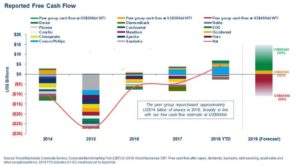Wood Mackenzie: US independent E&P players look to balance their books
According to Wood Mackenzie, the US Lower 48 E&P sector is under pressure from investors demanding greater capital discipline, positive free cash flow and increasing returns. There’s a tug-of-war between value and volume, and value has emerged as the winner.

The Lower 48’s independents, who traditionally pursued growth at all costs, must now rein in their impulses and focus on delivering returns to their shareholders. How does this affect their 2019 spending plans, and how do they manage volatile oil prices?
“As US independents release their budgets over the course of this month, we expect to see their growth aspirations take a back seat,” Roy Martin, from Wood Mackenzie’s corporate analysis team, said. “Cash flow neutrality is more important than ever – and this will be the key focus as companies announce their 2019 guidance.”
“Investment will be adjusted down as oil price expectations have slipped,” Mr Martin added. “But at prices above $50 a barrel WTI, shareholder distributions will be higher up the capital allocation pecking order than investing for growth.”
“Organic free cash flow – if generated – will play an important role in sustaining share buyback momentum,” Mr Martin said.
With prices at $50/bbl WTI, to achieve cash flow neutrality this year, Wood Mackenzie estimates that, as a group, US independents need to cut spending by 6% relative to 2018 levels.
“Hess, Apache and Noble are under the most pressure at $50/bbl WTI, but they are focused on delivering large-scale capital intensive projects this year,” Mr Martin said. “Many companies have already set activity levels with the aim of achieving cash flow neutrality around $50/bbl, most notably tight-oil stalwarts Pioneer, Concho and Continental.

“Free cash flow generation at $60/bbl WTI is broadly in line with the $14 billion of share buybacks announced by the peer group in 2018. Buybacks and debt repayment are likely to soak up the majority of the surplus free cash flow at higher prices,” Mr Martin added. “Those companies with the strongest tight oil portfolios will find it tempting to relax capital discipline at prices higher than $50/bbl WTI.”
“Top-flight operators such as Pioneer, EOG and Concho command vast tight oil positions in the Permian with NPV 15 breakevens below $40/bbl WTI. These low breakeven assets underscore the strong incentive to invest. But we expect shareholders to be favored in the distribution of surplus cash flow – moderate dividend increases for some; buyback programs for most,” Mr Martin said.
“Those companies carrying higher debt and with weaker free cash flow outlooks will find lower prices more challenging. Having divested over $50 billion of assets since 2015, most of the low-hanging fruit has already been sold, highlighting the pressure for companies such as Apache and Chesapeake to dial down capital expenditures at lower prices,” said Mr Martin
“Expect fast reactions to price signals. Consolidation is likely to remain a core theme – driven by a variety of strategies, including the desire to improve returns, deleveraging via equity-backed corporate acquisitions, or simply opportunistically taking advantage of valuation multiples in an unloved sector,” Mr Martin concluded.




